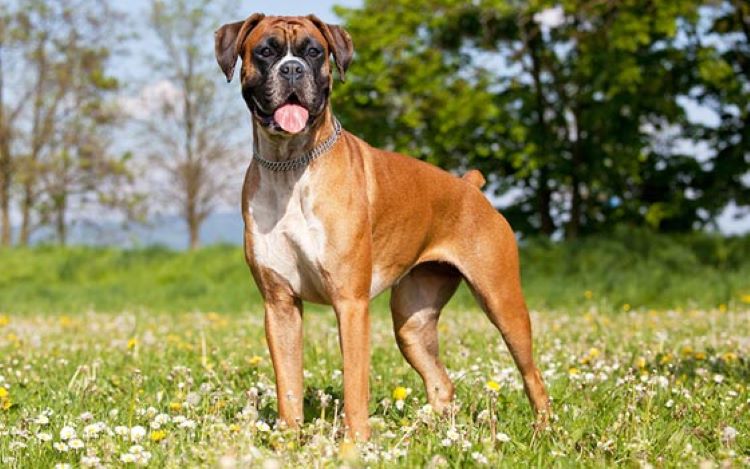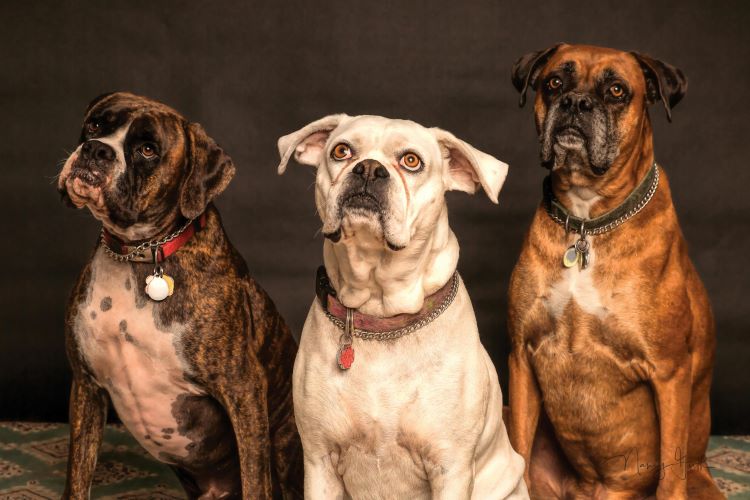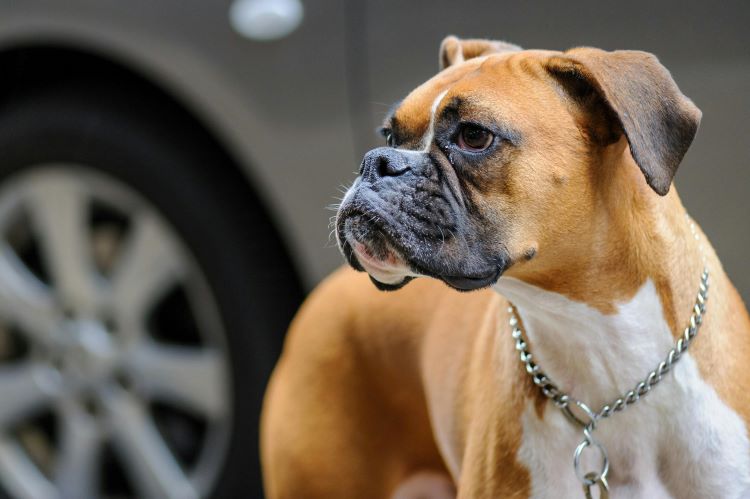Ready to help treat your pet to a healthy life?
Boxer Dog Breed Guide Fun Facts, Health & Care Tips
By : Trupanion Staff | Updated Apr 9, 2024

The Boxer is a medium to large-sized dog breed known for its muscular build, square-shaped head, smooth coat, and as many pet owners can attest, profoundly soulful and loving eyes. In addition to being known for their energy and athleticism, Boxers are often characterized by their playful and affectionate nature. As their name suggests, Boxers are also recognized for their distinctive "boxing" behavior, where they playfully bat at objects or people with their front paws. They require regular exercise and training to keep them mentally and physically stimulated, but they can form strong, lasting bonds with humans.
Wondering if Boxers make good pets or just curious about what makes these dogs unique? This breed guide has you covered with fun facts, care info, and more!
10 Fun facts about Boxers
- When a Boxer gets excited, you’ll get to see the amazing whole-body wiggle the breed is known for, paired with hopping, spinning, and all-around joy!
- Boxers can be directly traced to a now extinct German breed called the Bullenbeiser, used for hunting elk and other large prey.
- Brandy, a Boxer from the state of Michigan, holds the world record for the longest dog tongue ever, measuring a whopping 17-inches long!
- Boxer puppies are naturally born with a long tail and floppy ears (unless they’re part of a breeding line of naturally bob tailed Boxers created through selective breeding). As docking and cropping have grown more unpopular in recent years, you’ll usually only see a Boxer with cropped ears and docked tail in the show ring in the US. In the United Kingdom, cropping and docking has been banned and Boxers can be seen there with the most wonderful wiggly tails.
- Boxers are best known for having a light brown or "fawn" coat with a white stomach and chest, but they can come in other colors as well. More rarely, Boxers can be found with a brindle pattern or all-white coats.
- Approximately 1 in 5 Boxers have a white (or mostly white) coat — and an estimated 18% of these white Boxers are deaf in at least one ear, if not both. The piebald gene associated with the white coat color is also associated with deafness.
- Boxers were one of the first dog breeds used by German police and were later used by the German military during World Wars I and II as guard dogs and messengers.
- The name "Boxer" is said to come from their tendency to play by batting at objects with their front paws, resembling the movements of a boxer in the ring. However, not all Boxers engage in this behavior.
- When fully grown, the Boxer breed tends to measure between 20 and 25 inches tall at the shoulder and weighs between 55 and 65 lbs (55 to 29.48 kg).
- Boxers tend to live between 8 and 12 years, though some have been recorded as living much longer.
Get to know the Boxer
Like many dog breeds, Boxers have a distinctive appearance that is easy to recognize:
- Expressive eyes
- Large, deep chest
- Lengthy jowls (which can mean lots of drool!)
- Underbite
- Flat faces (brachycephalic)
Boxer temperament
You’ll always know how a Boxer is feeling! They’re expressive, fun-loving, and silly. But if they feel like their family is in danger, they’re excellent guardians and protectors. Full of energy and seemingly boundless joy, this breed is ready to go-go-go. They were bred as working dogs but make loving companions - quite adept at snuggling on the couch, many think they’re lap dogs. Though their medium size makes this a bit difficult, that doesn’t stop them from trying. As great contortionist, a Boxer will twist their body into a donut or pretzel shape and try their best to fit in your lap so they can be closer to you.
Similar dog breeds
- English Bulldog
- Bull Mastiff
- Great Dane
- Dogue de Bordeaux
- Staffordshire Bull Terrier

History of the Boxer
The Boxer breed was developed in Germany toward the end of the 19th century. They’re thought to be descendants of the
Bullenbeiser, a breed used for hunting large game and other activities requiring strength and stamina. Nevertheless, the Boxer’s ancestry can be traced back even further to
the Molossian dogs of 2000 B.C., who were the foundation for many European breeds like the Great Dane,
Mastiffs, Bulldogs, and terriers. Molossians were a strong, large-headed breed used in Assyria for hunting
and as war dogs. They made their way across the European continent over time, particularly during the Roman
conquest. Over time, the Molossian breed evolved into the Bullenbeisser.
Before the Napoleonic wars, the Bullenbeisers were primarily kept by nobility who could afford to care for large packs of hunting dogs. But after 1800, these dogs began working for butchers and cattle drivers. Over time, they grew smaller in size and took on the role of family dog and guardian. In 1895, the first Boxer breed club was formed in Munich, Germany. This club created the breed standard and held the first dog show exhibiting the Boxer.
Breed development in North America
While the American Kennel Club recognized the breed in 1904, it didn’t gain popularity in the States until the mid-20th century. According to the American Boxer Club, Boxers bred in the United States can trace their lineage back to the “Four Horsemen of American Boxerdom,” four male Boxers imported from Germany named Sigurd, Dorian, Utz, and Lustig. One of Dorian’s descendants, named Bang Away, won Best in Show at the Westminster Dog Show in 1951 and the breed’s popularity in the United States took off. As a result, they’ve consistently ranked in the top 10 most popular dog breeds.
While not much has changed in the breed standard since the original was created in 1895, the cropping of Boxers’ ears when they are puppies has fallen out of fashion. The cropped ear is usually only seen in Boxers bred for the show ring, but in 2005 the American show standard began to allow the natural ear. While tail docking remains prevalent, more and more Boxer puppies are also being left with their full tail in Europe and around the world.
Do Boxers make good pets?
As working dogs, Boxers have been used in a variety of roles over their history, from police dogs to therapy dogs. However, they can also make great pets for both families and individuals.
While they are highly versatile, it’s important to provide them with appropriate outlets for their energy and give them the attention they crave. Without proper discipline or enough exercise, these dogs can act out and may be tough to train. Nevertheless, Boxers love being with their people and are known for being both guardian and comforter.
Training
Many people describe Boxers as being a “headstrong” and tough-to-train breed, but this just isn’t true! It all comes down to knowing what motivates them and using it to your advantage. They’re descendants of the bulldog and terrier breeds, created specifically to work independently and not give up, so a little hard-headedness is to be expected. With positive reinforcement training methods and consistency, a Boxer is a joy to train and will be an excellent companion. Boxers can also be sensitive to harsh scolding or yelling. Punishments, whether verbal or physical, not only damage the relationship between a Boxer and their owner but also tend not to work in the long run. Often, it creates long-term behavioral issues. By focusing on teaching a Boxer what to do, rather than on unwanted behaviors, they’ll be well-behaved and happy dogs!
Even so, it's important to remember that Boxers are smart dogs and can lose interest in training unless it’s varied, fun, and positive. After all, the breed’s lineage includes mastiffs, bulldogs, and terriers, bred to be hard-working and able to think independently. It’s all about building solid, positive training habits from puppyhood and knowing your Boxer’s motivators.
Boxers do best with consistent positive reinforcement training. Many love working for food (who doesn’t?), but also find toys and play with their human very rewarding.
How do Boxers get along with others?
Boxers are natural guardians, making them somewhat cautious and reserved when meeting new people. But once you’ve become a friend, they’re much more comfortable showing you their goofy side. Due to their protective nature, proper proactive exposure to new sights, sounds, people, dogs, and other animals as a young puppy is essential for their socialization skills.
Boxers are a frequent breed choice for families with children. They’re playful, protective, and can tolerate the physical handling of young kids when properly socialized. Their medium to large size might be a bit overwhelming for small children, and their exuberant Boxer nature could lead to the occasional knock down. Introducing your Boxer to children as a puppy will help set them up for success. Young children and dogs should always be supervised, and it’s helpful for a dog to have their own “safe space” where they can go when they need some quiet time.
When it comes to animal buddies in the home, it’s once again, all about socialization. Boxers can enjoy and benefit from the companionship of other animals. But be aware, they’re high-energy, rough-and-tumble players that can overpower and scare other dogs. They also have prey instincts that can make it difficult to pair them with cats or smaller animals. Start teaching proper play behaviors while your Boxer is a puppy. And it’s important to always supervise play between a Boxer and other dogs to keep it fun for everyone.
How much exercise do Boxers need?
Daily exercise is so important for this bouncy working breed. Boxers need more than just a daily walk. They make good jogging partners. Just be cautious with exercise in warmer temperatures or high humidity, and provide lots of breaks and water. Boxers, like all flat-faced breeds, should always be monitored for heatstroke symptoms, which often include: heavy panting, drooling, bright red tongue or gums, rapid pulse, and wide, panicked eyes.
Speak with your veterinarian about appropriate exercise for a Boxer puppy. Until they are full-grown (bone growth plates typically all close by around 12 to 18 months of age), avoid jogging or running beyond what they would do on their own. This helps minimize risk of damage to the growing bone and cartilage, which can cause pain and future joint issues.
Mental enrichment
A variety of mental enrichment is essential for a happy and well-behaved Boxer. They are always looking for what to do next. It’s important to keep their focus on acceptable behaviors, otherwise, they might decide digging up your backyard or chewing a hole in your wall is a great idea.
You can work their brains by teaching new tricks, attending obedience classes, joining a dog sport, and providing dog puzzles and interactive toys. Boxers are athletes and love to play fetch — tap into their strengths and sign up for Flyball!
Activities for Boxers
- Flyball
- Agility
- Nosework
- Therapy Dog
- Rally Obedience
- Search and Rescue

Grooming and care
Boxers have a short, smooth, single-layer coat that’s easy to maintain. But this short fur doesn’t provide much insulation, so it’s a good idea to bundle them up with booties and a sweater or jacket when it’s cold. They come in fawn (ranging from red to tan), brindle, or white colors and patterns. White Boxers are more likely to be deaf, as the same piebald gene that causes white coloring is also linked to congenital deafness.
Boxers need weekly brushing, which helps evenly distribute the natural oils in their coat and remove any dirt and shedding fur. Regular bathing is recommended for this breed as well, with special care to keep their face wrinkles clean and dry, which keeps the yeast and bacterial populations in check and prevents uncomfortable and recurrent infections. Introduce your puppy to the grooming experience from a young age to create a positive association and make lifelong grooming easy for everyone.
Best Brush for a Boxer: Bristle brush, rubber curry brush
Health concerns
All dog breeds come with certain health concerns or conditions they may be predisposed to due to their breeding. As an established dog breed without as much genetic diversity as a mixed canine, the Boxer is no exception to this. For example, they are a brachycephalic breed with a specific nasal structure that can result in respiratory issues. The good news is that if you're considering adopting a Boxer, this does not necessarily mean they'll come with a chronic health condition or debilitating illness. However, it does mean that you should be aware upfront of what kinds of things your pet may be more at risk of (signing your pet up for dog health insurance early on can help give you peace of mind).
Some of the more common health conditions affecting Boxers include:
- Brachycephalic Syndrome — Boxers have a short muzzle, which can lead to breathing difficulties, especially in hot or humid weather.
- Hip Dysplasia — A condition where the hip joint doesn't fit together properly, leading to discomfort and eventually arthritis.
- Cardiomyopathy — A type of heart condition that can affect Boxers, particularly a form known as Boxer Cardiomyopathy, which can be genetic.
- Aortic Stenosis — A heart condition characterized by narrowing of the aorta, which can lead to poor blood flow and heart problems.
- Degenerative Myelopathy — A progressive disease of the spinal cord that can lead to paralysis.
- Cancer — Boxers may be prone to various types of cancer, including mast cell tumors and lymphoma.
- Bloat — Gastric Dilatation-Volvulus or "dog bloat" is a life-threatening condition where the stomach fills with gas and twists on itself. It requires immediate veterinary attention.
- Hypothyroidism — A thyroid disorder that can cause weight gain, lethargy, and skin problems.
- Allergies — Boxers may be prone to skin allergies and food sensitivities.
- Corneal Dystrophy — A condition affecting the cornea of the eye, which can lead to vision problems.
If you are a Boxer owner, it's important to be aware of these potential health issues and to work closely with their veterinarian to ensure your dog's health and well-being. Regular veterinary check-ups, proper nutrition, exercise, and attention to grooming and dental care can all help mitigate some of these concerns. Additionally, responsible breeding practices aimed at reducing the incidence of genetic diseases and promoting genetic diversity can help improve the overall health of the breed.

Boxers in pop culture
Thanks to their sweet natures and versatility, Boxers are widely popular in internet videos and have graced the homes of celebrities both past and present.
Famous Owners of the Boxer
- Justin Timberlake & Jessica Biel (Singer, Actress)
- Kate Upton (Model)
- Lauren Bacall & Humphrey Bogart (Actors)
- Billie Holiday (Singer)
- Jennifer Lopez (Singer/Actress)
- Greg Biffle (Race Car Driver)
- Chelsea Handler (Comedian)
- Bette Davis (Actress)
- Tom Hardy (Actor)
- Luke Perry (Actor)
Famous Boxer
Punch and Judy were a dog duo who received Dickin Medal awards for heroic acts that saved two British military officers under attack.
